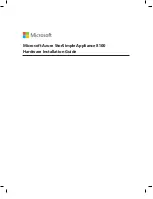
Altos R5250 Installation Configuration Guide
102
need to manually create three partitions: “/boot”, “swap” and a root “/”
partitions during installation. You will also need to convert Device Name
to Device ID with its associated mount point while creating each partition.
The Step 8 ~ step16 below will instruct you on how to create these three
required partitions with its associated mount point and how to convert
Device Name into Device ID.
NOTE: Normally, a file system to mount is identified in /etc/fstab by the Device
Name. This identification can be changed so the file system to mount is found
by searching for a Device ID or Volume label.
8.
At Installation Setting, Click Partitioning .
9.
Select Create Custom Partition Setup option box, and click Next
10.
Select Custom Partitioning (for experts) option box, and then click Next
11.
To create a partition, click Create at the bottom and then select Primary
Partition option box.
12.
In creating the “/boot” partition, you need to fill in the ‘Mount Point’
with “/boot”. For the “swap” partition, you will need to enter the size of
the partition. Set it to ‘+1GB’ which is plenty. Then click the tab Fstab
Option.
13.
You will see Device Name is the default option in the section labeled
‘Mount in /etc/fstab by’. Then change the Fstab options to Device ID and
click OK at the bottom.
14.
In creating the “swap” partition, please follow step described in step11 –
step13. In addition, you need to change File system from ‘Reiser’ to ‘Swap’
in the combo box. And don’t forget to fill in the ‘Mount Point’ with
“swap”. The typical size of the partition is ‘+1GB’.
15.
In creating a root “/” partition, please follow step described in step11 –
step13. and to fill in the ‘Mount Point’ with “/”. Typitically, assign rest of
available driver space for the root partition “/”.
16.
Once all the partitions are created, click Finish to proceed with normal
installation.
17.
If you have installed the ATI FireGL V5200 in the system, you need to
install addition packages during the OS installation. If you are using
onboard XGI Z9s, please go to step 13 directly.
18.
At Installation Setting, select the Software.
19.
Check C/C++ Compiler and Tools under Development to add C/C++
compiler tools.
20.
Click on Details, change the Filter from Patterns to Package Groups.
21.
Select the Source under Development in left window and check kernel-
















































